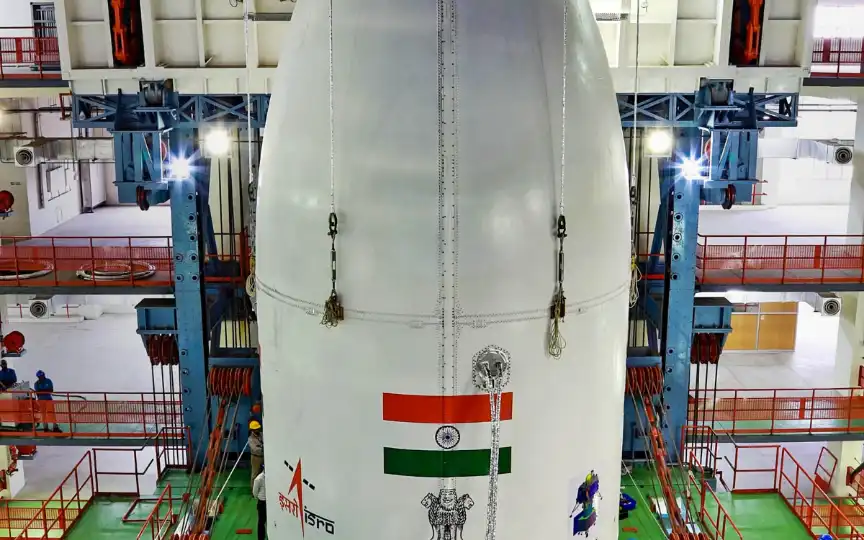India’s Third Moon Mission: Countdown to Chandrayaan 3 Launch Begins
The completion of the “launch rehearsal” on Monday is expected to mark the beginning of the countdown for India’s third moon mission, scheduled for July 14.
The “Launch Rehearsal”, which simulates the entire launch preparation and 24-hour process, has been completed, the Indian space agency said on Monday.
And just after 2:50 p.m. India’s Chandrayaan-3 spacecraft will begin its long journey to the moon on July 14 after being ejected by an LVM3 rocket.
After a journey of about 3.84 lakh km, the Chandrayaan-3 spacecraft is expected to land on the lunar surface on August 23 or 24.
The Chandrayaan-3 spacecraft includes a propulsion module (weight 2,148 kg), a lander (1,723.89 kg) and a rover (26 kg), the Indian Space Research Organization (ISRO) said.
By the way, Chandrayaan-2 payload weighed about 3.8 tonnes in orbit 2,379 kg, Vikram lander 1,444 kg (including Pragyan rover 27 kg).
The main purpose of Chandrayaan-3 is to land the lander safely on the lunar soil.
After this, the Rover rolls out to do some tests. The useful life of the payload carried by the propulsion module after the lander is thrown is three to six months.
On the other hand, the lifetime of the lander and rover is 1 lunar day or 14 Earth days, ISRO said.
According to the Indian Space Agency, the propulsion module carries the SHAPE (Spectro-polarimetry of Habitable Planet Earth) payload, which is used to study Earth’s spectral and polarimetry measurements from the Moon’s orbit. The lander’s payloads are: Chandra’s Surface Thermophysical Experiment (ChaSTE) to measure thermal conductivity and temperature; Instrument for Lunar Seismic Activity (ILSA) to measure seismicity around the landing site; Langmuir Probe (LP) to estimate plasma density and its variations.
NASA’s passive laser retroreflector Array is intended for laser ranging studies of the moon. On the other hand, the rover will carry: Alpha Particle X-ray Spectrometer (APXS) and Laser Induced Breakdown Spectroscope (LIBS) to derive the elemental composition in the vicinity of the landing site, ISRO said.
According to ISRO, the lunar mission is divided into three phases – the Earth-centered phase (Pre-Launch, Launch and Ascent and Earth-bound Maneuver), the Moon transfer phase (Transfer Trajectory) and the center of the Moon (Moon orbit). Acceleration phase, Moon-bound control phase, Propulsion module and lunar module separation, Power-down phase, Pre-landing phase, Landing phase, Normal phase for Lander and Rover, Lunar-centric normal orbit phase (100 km circular orbit) for Propulsion Module.
In the first stage, India’s heavy-lift rocket, which is 43.5 meters tall and weighs 642 tonnes LVM3, will carry the Chandrayaan-3 spacecraft. The rocket has an unblemished record of six consecutive successful missions.
This is LVM3’s fourth operational flight and aims to launch the Chandrayaan-3 spacecraft into Geo Transfer Orbit (GTO).
At 14:35 on July 14, a three-stage LVM3 rocket blasts off from the second launch pad at the Sriharikota rocket port in Andhra Pradesh. The first stage of the first rocket runs on solid fuel, the second stage on liquid fuel, and the third and final stage consists of a cryogenic engine that uses liquid hydrogen and liquid oxygen.
At the moment of detonation, the propellant mass of the 642-ton rocket is 553.4 tons – all three stages in total. A little over 16 minutes into the flight, the rocket throws the Chandrayaan-3 spacecraft to an altitude of about 179 kilometers.
The current mission is a follow-up to the failed Chandrayaan-2 mission in 2019, when a lander named Vikram crashed into the lunar surface. As for the changes made to the lander this time compared to the lander that landed on the moon during the Chandrayaan-2 mission, a senior ISRO official told IANS that the lander has four engines instead of five.
The Space Agency has also made some changes to the software.
Interestingly, ERO is silent on naming the landers and the Rover this time. During the Chandrayaan-2 mission, the lander was named Vikram and the rover was named Pragyan.




